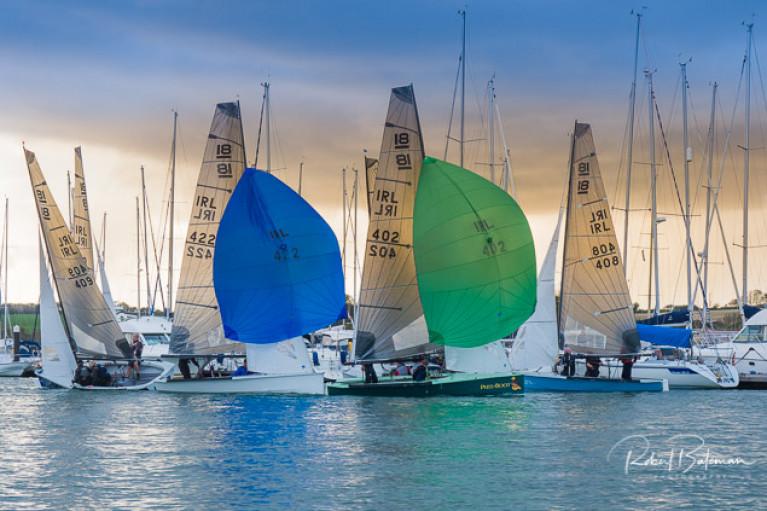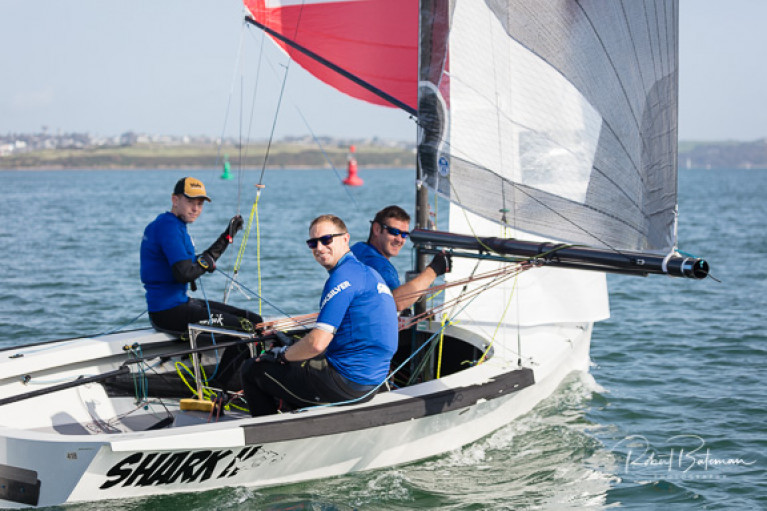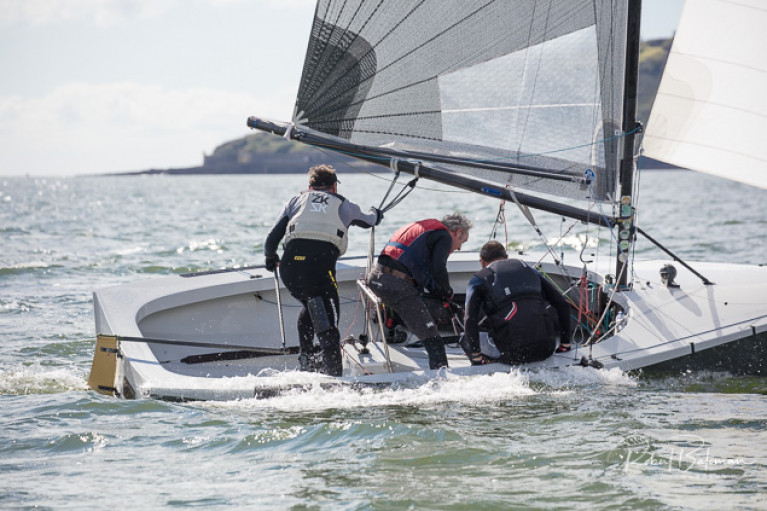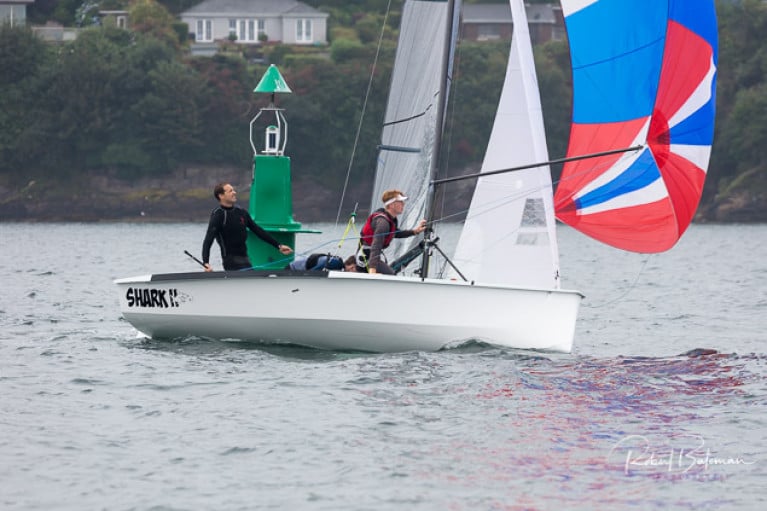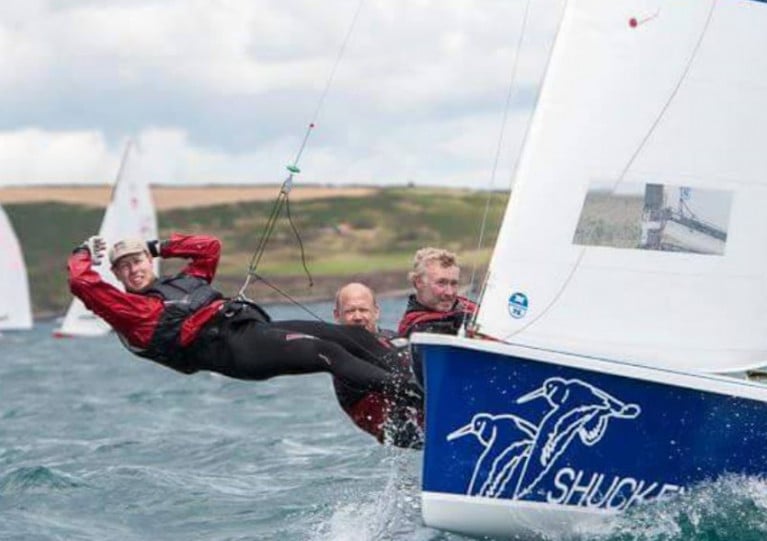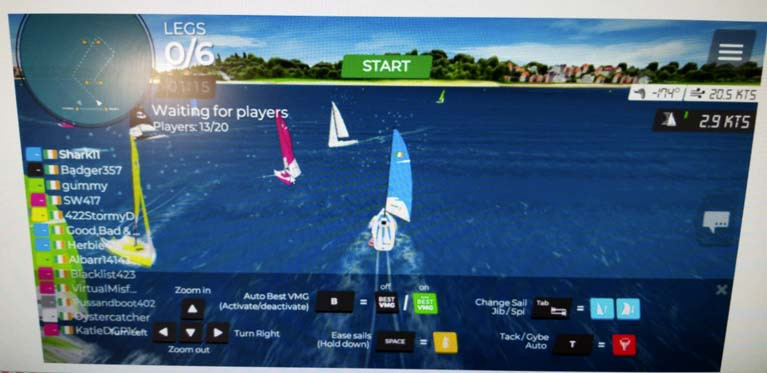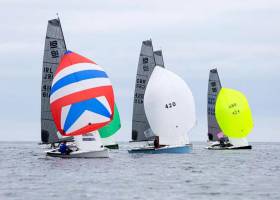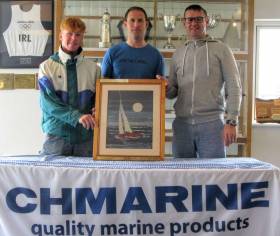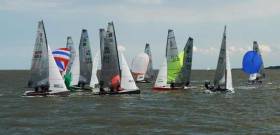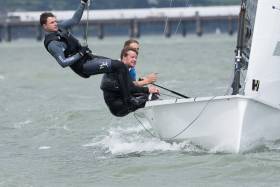Displaying items by tag: National 18
Nick Walsh's Fifty Shades was the first to finish the National 18s River Race held last night at Royal Cork Yacht Club in Cork Harbour.
The Owenabue race marked the final race of the season for the dinghy class and there was an enthusiastic turnout of all but one of the (new) designs, giving an 11-boat fleet.
The weather threw in everything for the finale; evening sunshine, dark clouds, a shower, light winds and finally a shower that brought more breeze and a rainbow.
With the tide in but ebbing the course was a beat to a weather mark, a run downwind and then a right turn into the marina in front of the RCYC clubhouse, rounding a mark back out to continue the run to leeward mark.
National 18 dinghy River Race photo slideshow below
'Fifty Shades' is Irish National 18 Champion After Eight Race Series off Cork Harbour
Fifty Shades sailed by Nick Walsh, Rob Brownlow and Eddie Rice are the winners of the 2020 National 18 Foot Class Irish National Championships after an eight race series sailed off Cork Harbour at the weekend.
Walsh and crew won by six points from FOMO sailed by Alex Barry, Andrew Woodward and Grattan Roberts. Third in the nine boat fleet was Colin Chapman's Aquadisiacs sailing with Eric Lyons and Morgan O'Sullivan.
Full results are here.
Barry, Rimmington & Leonard Triumph at National 18 Southerns in Cork Harbour (Photo Gallery)
Alex Barry, Sandy Rimmington and Richard Leonard sailing Aquadisiacs were the overall winners of an 11-boat National 18 Southern Championships at Royal Cork Yacht Club last weekend.
The Royal Cork/Monkstown Bay trio won by a margin of three points over Barry's older brother Ewen steering FOMO crewed by Stanley Brown and Dion Barrett on 14 points. Two points back was third overall, Fifty Shades sailed by Laser ace Nick Walsh, Rob Brownlow and Eddie Rice.
The Aquadisiacs crew sailed a consistent seven-race series on Cork Harbour dipping only once out of the top three in a scoreline that included two race wins.
National 18 Southern Championships 2020 Results
 National 18 Southern Championships 2020 Results
National 18 Southern Championships 2020 Results
See National 18 Southerns photo slideshow by Bob Bateman below
National 18s Dognose Trophy Won By Shark II (Slideshow Here!)
The winner of the National 18s Dognose trophy sailed on Saturday in Cork Harbour was Shark II skippered by Charles Dwyer.
The one-day event at the Royal Cork Yacht Club marked a welcome return to the water for the three-man dinghy class after the disappointing cancellation of the national championships this month at the same venue.
Dwyer and his crew are continuing their winning form from 2019, having won the Southern Championships in Baltimore, West Cork.
As Afloat reported previously, unfortunately, the class will also miss out this October on its chance to host the All-Ireland Sailing Championships due to the format of the event and COVID restrictions.
See Bob Bateman's slideshow of photos from the 2020 Dognose Trophy below.
National 18 Championship 2020 Cancelled Due To Covid-19
The National 18ft Class Association has very reluctantly concluded that they must cancel the 2020 UK & Irish Championships sponsored by AIB.
The event was due to be held in the Royal Cork Yacht Club this August as part of the Cork300 celebrations.
However, the remaining Government restrictions against coronavirus, in particular those on foreign travel and social distancing, will make it impossible to run a successful event, the organisers said.
Many options were considered, including a deferred 2020 date. But to protect the health of all and the sailing and social integrity of the regatta, the decision has been made to cancel.
Despite the disappointment, plans for a domestic season both in Ireland and the UK are under way with a revised calendar will be issued in the coming weeks, and an announcement on the rescheduling of the Class Championships will follow.
The cancellation does not impact the AIB-sponsored Optimist Nationals or the Laser Nationals, which are also planned for August but later in the month.
Wednesday, April 1st marked the day that the Cork Harbour National 18 fleet would begin their April League. This league is traditionally marked as the beginning of their racing season. As was predicted, the crewed-by-three 18 footers had their league cancelled. This was of no moment to the big dinghy class and soon enough, racing had been organised elsewhere.
Unfortunately, the races would not be run in any of the usual spots. Instead, the National 18 class decided to take a step into the unknown world of virtual online sailing. No beauty scenes to be spoken of, but in replacement of the gulls and sunlight there would be simple, short and competitive online racing for the National 18 fleet.
A competitor from each boat would enter the six races scheduled. With the first gun set for 20:00 pm, twenty boats lined up on the start line to begin race one. It became evident who had been practising, with the computer-savvy competitors flying into the lead. Unfortunately, the game crashed for most of the fleet and had to be abandoned. We’ll pretend it was a squall.
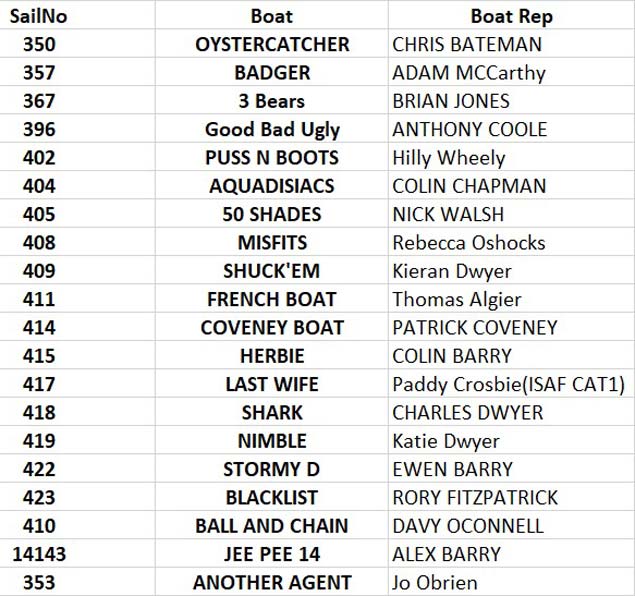 The online National 18 fleet
The online National 18 fleet
Race two began with closer racing, as the fleet improved their button pressing. It’s no mainsheet, but the racing was tight and competitive. Wildcard Alex Barry racing his GP14 “Gee Pee” took out race two. In second place was Charles Dwyer racing his 18 “Shark II”. Making up third was Adam McCarthy, racing the well known “Badger”.
Race three was close but eventually taken out by Colin Barry racing “Herbie”. Staying consistent in second place was Dwyer in “Shark II”. In third place was Paddy Crosbie, racing “Second Wind”.
By the time race, four came around, the buttons had been pressed enough for the stragglers to take on the “gamers”. McCarthy in “Badger” dominated the fleet and won the race. In second was Colin Barry racing “Herbie” and in third was the familiar “Shark II” raced by Dwyer. By this stage, it was clear who was the dominant force, with race four being taken out by Crosbie in “Second Wind”. Keeping a consistent second was “Shark II” raced by Dwyer, with old “Badger” raced by McCarthy making up third.
The final race of the day was won by “Badger” raced by Adam McCarthy, who pulled into the overall lead with his two strong bullets. Coming second in that race was “Oystercatcher” (raced by your overjoyed and slightly confused correspondent). Making up third was Paddy Crosbie in “Second Wind”.
Overall, a brilliant start to the virtual National 18 April League. Great fun and great racing, even without the smell of the sea. In the end, it’s all good craic. We believe Rory Fitzpatrick in “Blacklist” came the closest to genuine freshwater activity, having attempted to take his iPad for a swim mid-race.
Next week’s racing will be held in the same place, with all National 18’s and their representatives present and correct.
Charles Dwyer's Shark II Triumphs at National 18 Cock O'the North UK & Ireland Champs
National 18 sailors converged in usual strong spirit at the Royal Findhorn Yacht Club, to compete in their annual UK and Ireland Championships that were held last week writes Chris Bateman
With the event officially kicking off on Sunday (28th July), a week of good racing was in store for the competitors.
It was a fresh start for day one, with a solid 10-15 knots from the north blowing down the bay. Still on form from his win at the National 18 Southerns, Charles Dwyer on the helm of the ultra ‘Shark 11’ took the win for the first race of the day.
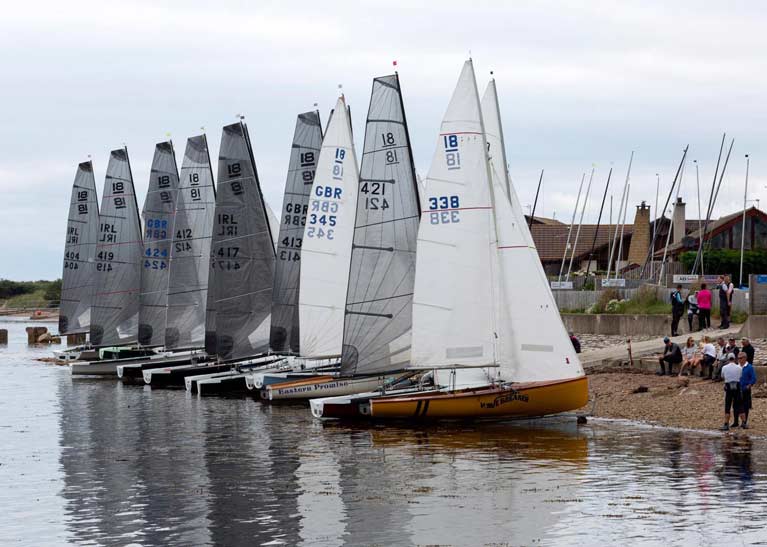 The National 18s at Royal Findhorn Yacht Club
The National 18s at Royal Findhorn Yacht Club
Light winds were on the menu for the next couple of days. The breeze took some time to find itself each morning, and the sailors had to wait about an hour (average) each day for it to settle. Once filled in, a fickle 5-8 knot breeze was the maximum.
Colin Chapman helming the ultra ‘Aquadisiac’ was on form, sailing well and leading the fleet for the first half of the week. This meant that he won the prestigious ‘Cock of the North’ trophy.
A lay-day on Wednesday marked the halfway point of the week, giving the competitors an opportunity to get a lie-in and enjoy Scotland for a day.
Racing in the ‘Ultimate’ fleet, the dominant force was ‘Fat Girl Racer’ who took seven bullets out of ten races. The numbers may have been lower in the Ultimate fleet, but the racing was as tight as any. Thirteen boats made up the ‘Ultra’ fleet, which made the event very competitive.
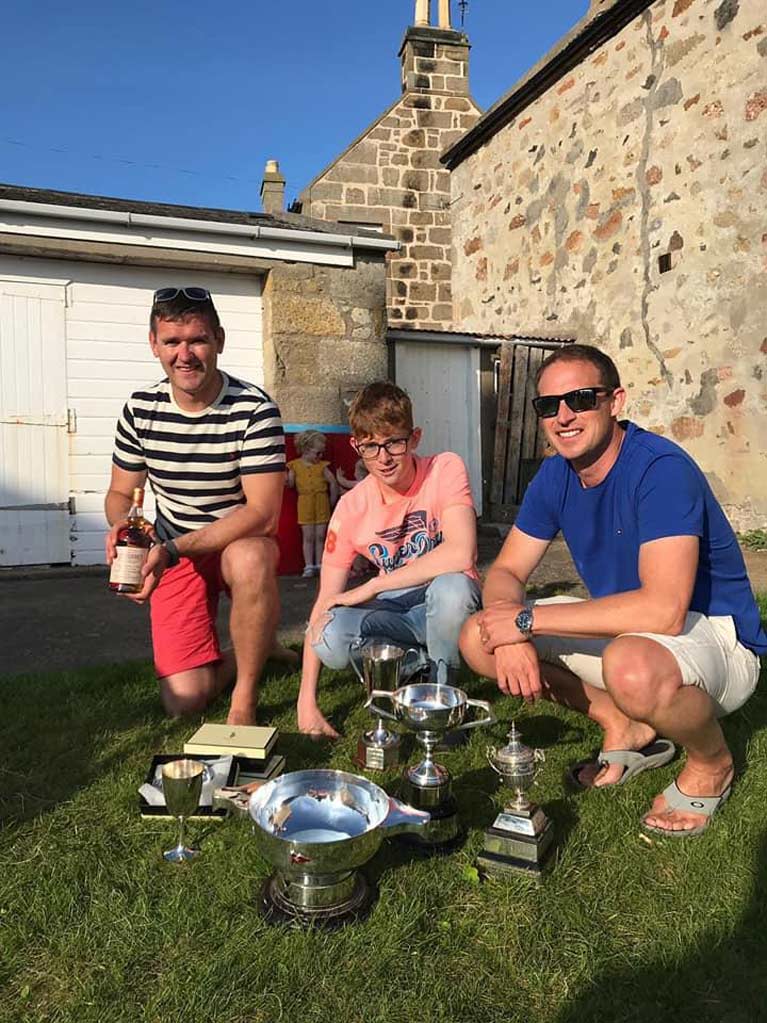 Winners - Charles Dwyer, John Coakley and Harry Pritchard
Winners - Charles Dwyer, John Coakley and Harry Pritchard
The second half of the week in progress, and in the Ultra fleet ‘Shark 11’ was back on form, with several bullets under their belt. The 18’s were now competing for the overall championship trophy, but the points were tight. Leading up to the last day, any five teams could have won.
The final day of the championships rolled around. Five teams had a chance at the title, the best performing one would take the lead. Light winds made the racing tricky, but ‘Shark 11’ secured two bullets.
The winners of the UK/Ireland championships with a comfortable 10 point lead were Charles Dwyer, John Coakley and Harry Pritchard, sailing ‘Shark 11’. Charles is the third generation of Dwyers to win the championships, with Tom, his father and Charlie, his grandfather having won on a few occasions over the last 70 years. It is a testament to the long history of the class.
Next years championships will be hosted by the Royal Cork Yacht Club, to celebrate the 300th anniversary of the club.
The CH Marine sponsored National 18 South Coast Championship fleet gathered in West Cork on June 1 to race on the beautiful waters of Baltimore Harbour.
The championships attracted a fleet of nine 18s. These nine boats were seen rigging at the top of the slip to be on the water in time for a noon start.
A windward/leeward with a spreader mark was the course for the day. The 18s jostled on the start line until race one was underway. A light fickle breeze made tactics very difficult and the sailors had to go fast towards the best side of the course, tending towards the left. Four rounds were scheduled for all races but with the light winds the course was shortened to three rounds. Charles Dwyer helming “Shark” took first place, staying ahead of Tommy Dwyer helming “Puss in Boots” in second, and Colin Barry and his team in third.
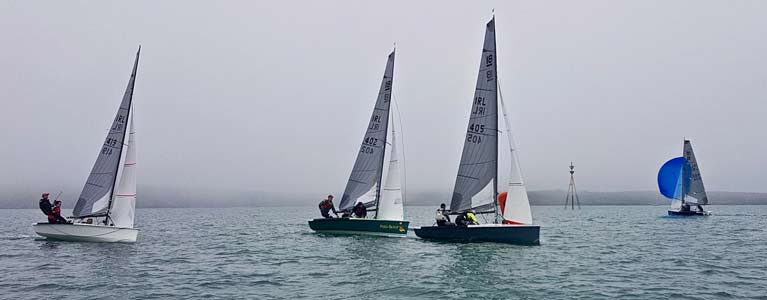 National 18s racing in Baltimore
National 18s racing in Baltimore
Race two began in slightly more breeze, having shifted slightly more into the south. With slightly patchier winds, there was a huge importance on looking for wind shifts. A shortened course and three rounds later saw Charles Dwyers “Shark” take first place. In second was Nick Walsh helming “50 Shades” and Tom Crosbie helming “Second wind” in third.
Race three kicked off and leading by round three was Colin Barry and his team. He held this lead to cross the finish line in first place. Second place was taken by Tom Crosbie, who finished just ahead of Nick Walsh in third place.
Race four, the last race of the day was started with increased wind. The breeze had swung even further into the left. Charles Dwyer held his lead and finished in first place, just in front of Tom Crosbie in third. Colin Chapman helming “Aquadisiacs” finished right behind in third place.
Sunday rolled around, and strong winds greeted the sailors. Wind readings of over 30 knots forced Day two to be abandoned. Once the National 18s were packed up, the sailors went into Baltimore Sailing Club for the prizegiving.
Taking first place was “Shark” helmed by Charles Dwyer. In second place was Tom Crosbie and crew in “Second Wind”. Taking third place was Colin Barry and his team.
The National 18s were out in force on the wide Blackwater estuary during the week of 15th to 20th July. Winds were in the south and were reinforced by sea breezes to a steady force 3 to 5. Add plenty of sunshine and this was the recipe for great sailing each day. Hosted in splendid style by West Mersea Yacht Club and Dabchicks Sailing Club with local expert Paul Jackson as Race Officer, some were saying it was the best event ever.
Entries came from England, Scotland, Ireland, the Isle of Man and France. Predominantly they were Morrison 'Ultras', but there were also a number of 'Ultimates' which raced in a separate fleet. Noticeable this year was an increase in family crews.
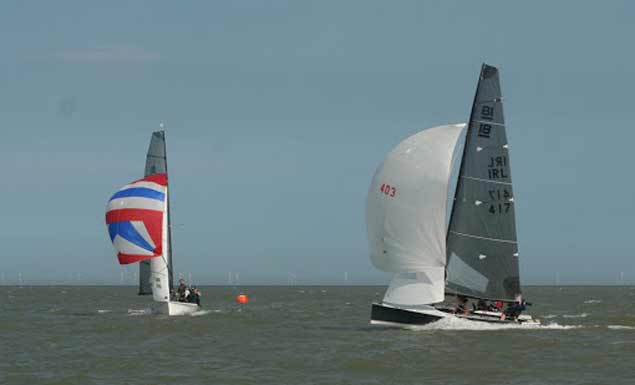 Second Wife and Shark Eleven in a gybing duel
Second Wife and Shark Eleven in a gybing duel
On the water there were three back-to-back races a day over four days, making 12 good races in all. Courses were windward/leeward leading to much close and tactical sailing and place changing both upwind and downwind. Early on and with several first places, it seemed that 'Shark Too' (Charlo Dwyer) would come out on top. However, 'Second Wife' (Tom Crosbie) took charge in the latter races. They ended equal on points overall, but the Crosbies took the major trophy by two points when the worst two results were discarded. Third was another Irish boat 'Fifty Shades' (Nick Walsh) and fourth a Scottish entry 'Two and half men' (Richard and Stuart Urquhart).
"On the water there were three back-to-back races a day over four days, making 12 good races in all"
It was noticeable that the English are closing the gap with two boats taking several top three places and 'Hurricane' (Ollie Houseman) taking sixth place overall.
The 'Ultimate' prize was won by Crossfire (Antony Ellis) from the Isle of Man in fine style crewed by his son Nickolas who, at 11 years old, was much the youngest competitor.
Ashore there was abundant night life with various oysters, belly dancers from Southend, musicians from Mersea Island, the 80th Anniversary Dinner and two jolly sing songs ending in traditional style with Tom Dwyer's rendition of 'Paddy McGinty's Goat'.
Results Ultra Class:
1st Second Wife (Tom, Chloe & Patrick Crosbie) Royal Cork Yacht Club
2nd Shark Eleven (Charlo Dwyer, Johnny Durcan, Robbie English) Royal Cork Yacht Club
3rd Fifty Shades (Nick Walsh, Rob Brownlow, Eddie Rice) Royal Cork Yacht Club
4th Two and Half Men ( Stuart & Richard Urquhart, Martin Cruden) Royal Findhorn Yacht Club
5th Aquadisiacs (Colin Chapman, Morgan O'Sullivan, James McCann) Royal Cork Yacht Club
6th Hurricane (Ollie Houseman, Jeremy Vines, Steve Watton) Tamesis/ Chew Valley Lake SC
Results Ultimate Class:
1st Crossfire (Antony & Nickolas Ellis, Stuart Brew) Isle of Man Yacht Club
2nd Muc Dhoo (Trevor & William Chanter, Lucy Smith) Bough Beech Sailing Club
3rd Raffles (Mathieu, Stephan & Laura Peretti) Centre Nautique de St Pol
Shark II Snaps Up National 18 Dwyer Cup in Cork Harbour
Charles Dwyer's 'Shark II' was the winner of the National 18s Dwyer Cup sailed from Royal Cork Yacht Club at the weekend.
Racing on the Whitegate side of Cork Harbour, second overall in the relatively small fleet was Ewen Barry's GBNB. Third was Patrick Crosbie's Second Wind. Scroll down for overall results.
See our photo gallery by Bob Bateman below
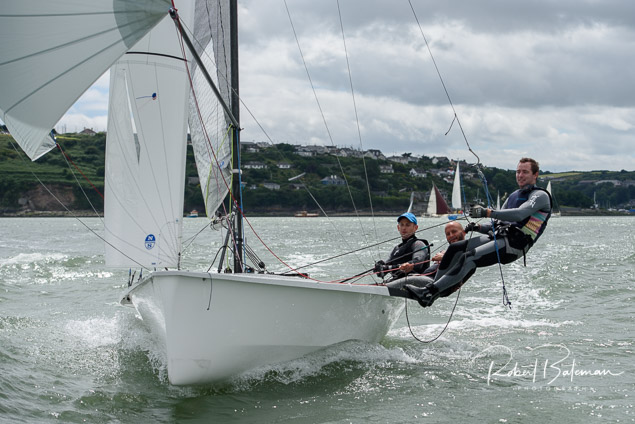 National 18 415, Herbie, skippered by Alex Barry with David Kenefick on the wire Photo Bob Bateman
National 18 415, Herbie, skippered by Alex Barry with David Kenefick on the wire Photo Bob Bateman
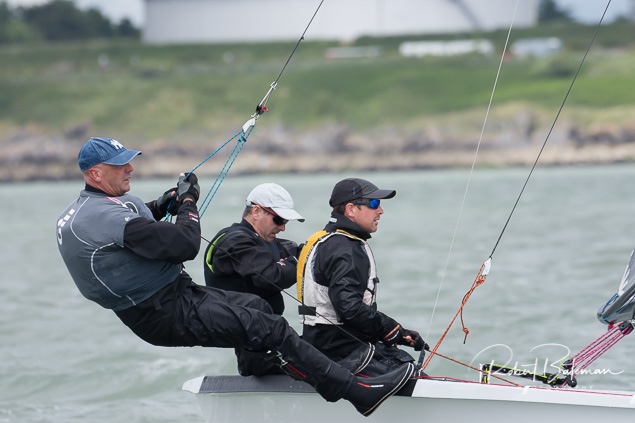 Ewan Barry's GBNB
Ewan Barry's GBNB
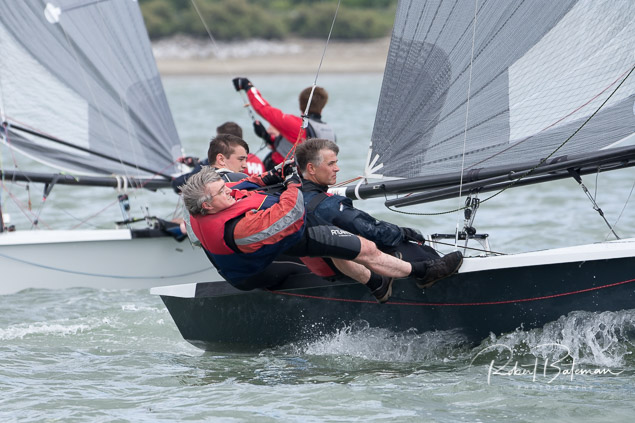 National 18 'Second Wave' skippered by Patrick Crosbie
National 18 'Second Wave' skippered by Patrick Crosbie
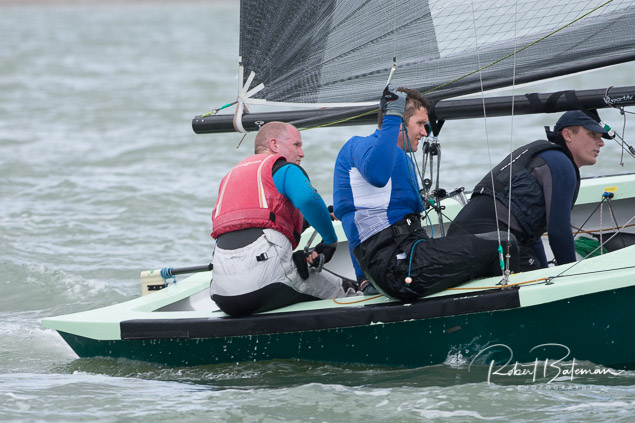 Willie Cotter's Puss in Boots
Willie Cotter's Puss in Boots
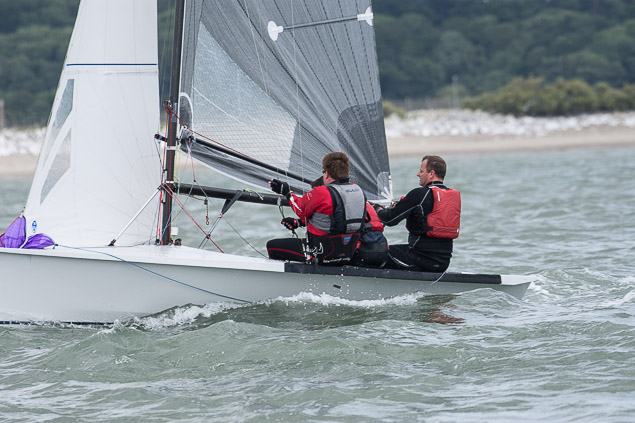 Colin Chapman's National 18
Colin Chapman's National 18
Overall results:
1st - 418 Shark II, Charles Dwyer
2nd - 422 GBNB, Ewen Barry
3rd - 403 Second Wind, Patrick Crosbie
4th - 415 Herbie, Alex Barry
5th - 404 Aquadisiacs, Colin Chapman
6th - 402 Puss ¹n Boot, Willie Healy


























